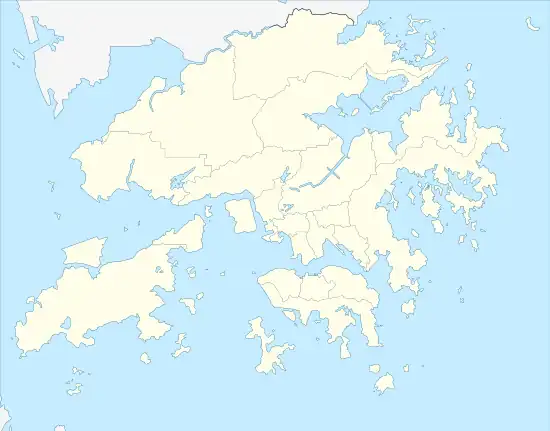Native name: 大頭洲 | |||||||||||||
|---|---|---|---|---|---|---|---|---|---|---|---|---|---|
 View of Tai Tau Chau from Shek O in August 2015 | |||||||||||||
 Tai Tau Chau | |||||||||||||
| Geography | |||||||||||||
| Location | near Shek O, Hong Kong Island | ||||||||||||
| Coordinates | 22°13′48.58″N 114°15′30.67″E / 22.2301611°N 114.2585194°E | ||||||||||||
| Adjacent to | Southern Waters of Hong Kong | ||||||||||||
| Administration | |||||||||||||
China | |||||||||||||
| SAR | Hong Kong | ||||||||||||
| Region | the Hong Kong Island | ||||||||||||
| District | the Southern District | ||||||||||||
| Demographics | |||||||||||||
| Population | 0 (2019) | ||||||||||||
| Additional information | |||||||||||||
| Chinese name | |||||||||||||
| Traditional Chinese | 大頭洲 | ||||||||||||
| Simplified Chinese | 大头洲 | ||||||||||||
| Literal meaning | Big Head Island | ||||||||||||
| |||||||||||||
Tai Tau Chau is an island in the Southern District, Hong Kong. Geographically, it is located in the southern Hong Kong Island. It connected to the Shek O Headland by a footbridge and a gravelbar (tombolo) under it. The island itself is uninhabited.
Geography
On the sides of Tai Tau Chau and Shek O Headland were Island Bay and Shek O Wan (Rocky Bay) respectively. On the south of Tai Tau Chau, is another island Ng Fan Chau. Shek O Headland and Tai Tau Chau are evidently as one rock formation, but was separated due to erosion, forming the tombolo between the headland and the island.[1]
History
The waters surrounding Tai Tau Chau and Shek O is a black spot for human smuggling and trafficking.[2] On 11 October 1979, a boat from Meilong, Haifeng County (Chinese: 海丰县梅陇镇), Guangdong Province, had sunk near the island.[3][4] It was reported that, as of 15 October 1979, 16 illegal immigrants from that boat were missing, which a few swam to Shek O Beach and trying to sneak to the city centre. And the rest of them were presume drown. Police also caught and rescued an additional 22 illegal immigrants, plus 9 corpses were discovered.[5] On 14 October 1979, another boat was discovered near the island, but the illegal immigrants escaped before the arrival of the police.[6] At that time Hong Kong had a policy that once the illegal immigrants had reached the city centre without being caught, they can apply for Hong Kong identity cards. The policy was terminated in 1980.
In 1982, another 15 illegal immigrants arrived Tai Tau Chau by using a sampan.[7]
Facilities
.jpg.webp)
Tai Tau Chau has footpaths for hikers.[8][9] It is part of Shek O Headland Picnic Area. Accidents were also reported. For example, a rock climber injured her legs when falling from the cliff of the island in 1977.[10] In 1990, another rock climber was rescued by the firefighter.[11]
The island was used to be connected to Shek O Headland by a footbridge, as well as a tombolo that would be covered by water during high tides. However, the bridge was destroyed by a typhoon in 2018[12] and being re-built as of 2019.[13]
Along the bridge deck, a waste water pipe was installed to transport waste water from Shek O Preliminary Treatment Works to the island[14] and then release to the Tathong Channel.[15] The pipe was also destroyed in that typhoon[16] and the waste water had polluted the beach nearby.[17]
References
- ↑ 蘇澤霖 [So, C.L.] (1983). "Landforms". In 趙子能 [Chiu, T.N.]; 蘇澤霖 (eds.). A Geography of Hong Kong. Hong Kong: Oxford University Press. p. 41. ISBN 0-19-581509-2.
- ↑ 洪琦琦 (27 October 2017). O記石澳搗越南人蛇集團 海陸空大搜捕 拉人前傳 直擊長洲部署. HK01 (in Chinese (Hong Kong)). Retrieved 29 December 2019.
- ↑ 石澳大頭洲怒海覆舟 四十七蛇客墮海 卅五人下落不明 [Boat sank near Tai Tau Chau, Shek O; 47 illegal immigrants falls into the sea; 25 of them were missing]. 工商晚報 [The Kung Sheung Evening News] (in Chinese (Hong Kong)). Hong Kong: Industrial and Commercial Daily Press. 12 October 1979. p. 1.
- ↑ 大頭洲怒覆舟 共撈兩具屍體 廿三人無踪跡. The Kung Sheung Evening News (in Chinese (Hong Kong)). Hong Kong: Industrial and Commercial Daily Press. 13 October 1979. p. 1.
- ↑ 大頭洲怒海覆舟 今再撈起兩男屍 罹難蛇客共九人. The Kung Sheung Evening News (in Chinese (Hong Kong)). Hong Kong: Industrial and Commercial Daily Press. 15 October 1979. p. 1.
- ↑ 西貢牛尾海及石澳 均發現大陸蛇客 大頭洲翻船十七人仍失踪. The Kung Sheung Evening News (in Chinese (Hong Kong)). Hong Kong: Industrial and Commercial Daily Press. 14 October 1979. p. 1.
- ↑ 大批非法入境者登陸大頭洲 警方圍搜石澳一帶 拘獲十六名偷渡客. 華僑日報 [Wah Kiu Yat Po] (in Chinese (Hong Kong)). Hong Kong. 2 May 1982. p. 7.
- ↑ 大頭洲 (石澳). 一起行山闖蕩去 [timhiking.com] (in Chinese (Hong Kong)). 25 June 2018. Retrieved 29 December 2019.
- ↑ "Scenery Routes" (PDF). Hiking Scheme (in English and Chinese (Hong Kong)). Hong Kong: Leisure and Cultural Services Department. c. 2015. pp. 30–31.
- ↑ 攀登石澳大頭洲山 女子墮山坡斷腿. Ta Kung Pao (in Chinese (Hong Kong)). Hong Kong. 6 April 1977. p. 4.
- ↑ 大頭洲攀石 崖健兒扭傷足踝 消防員助脫險. Wah Kiu Yat Po (in Chinese (Hong Kong)). Hong Kong. 8 October 1990. p. 4.
- ↑ 潘安奇; 林振華; 彭愷欣 (17 September 2018). 【颱風山竹】石澳「情人橋」難抵風浪粉碎 郊遊拍婚照勝地成追憶. HK01 (in Chinese (Hong Kong)). Retrieved 29 December 2019.
- ↑ 李慧妍 (28 April 2019). 石澳藍色「情人橋」災後重建? 居民:臨時給工人復修水渠之用. HK01 (in Chinese (Hong Kong)). Retrieved 29 December 2019.
- ↑ Environment Hong Kong 1994: a review of 1993. Hong Kong: Environmental Protection Department. c. 1994.
- ↑ 2.5公里外 無生物處理排污 石澳污水廠水辦驗出11干擾素. Ming Pao (in Chinese (Hong Kong)). Hong Kong: Media Chinese International. 27 July 2016. Retrieved 29 December 2019.
- ↑ "Sewage Treatment Works facilities and public sewers affected by Typhoon Mangkhut" (Press release). Hong Kong Government. 20 September 2018. Retrieved 29 December 2019.
- ↑ 政府維修慢臭水湧泳灘. Oriental Daily News (in Chinese (Hong Kong)). Hong Kong. 21 September 2018. Retrieved 29 December 2019.